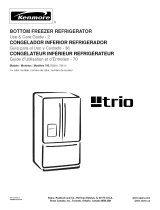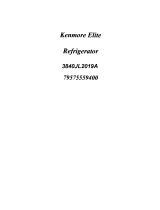IMPORTANT SAFETY INSTRUCTIONS
This guide contains many important safety messages. Always read and obey all safety messages.
This is the safety alert symbol. It alerts you to safety messages that inform you of hazards
that can kill or hurt you or others, or cause damage to the product.
All safety messages will be preceded by the safety alert symbol and the hazard signal word
DANGER, WARNING, CAUTION. These words mean:
ww
WARNING
To reduce the risk of fire, electric shock, or
injury to persons when using your product,
basic safety precautions should be followed,
including the following:
Read all instructions before using this appliance.
• NEVER unplug your refrigerator by pulling on the
power cord. Always grip the plug firmly and pull it
straight out from the outlet.
• Repair or replace immediately all electric service
cords that have become frayed or otherwise
damaged. Do not use a cord that shows cracks or
abrasion damage along its length or at either the
plug or connector end.
• When moving your refrigerator away from the wall,
be careful not to roll over or damage the power cord.
• DO NOT store or use gasoline or other flammable
vapors and liquids in the vicinity of this or any
other appliance.
• DO NOT allow children to climb, stand or hang on
the refrigerator doors or shelves in the refrigerator.
They could damage the refrigerator and seriously
injure themselves.
• Keep fingers out of pinch point areas; clearances
between the doors and cabinet are necessarily small.
Be careful closing doors when children are in the area.
• Unplug your refrigerator before cleaning or making
any repairs.
NOTE: We strongly recommend that any servicing
be performed by a qualified individual.
• Before replacing a burned-out light bulb, unplug
the refrigerator or turn off power at the circuit
breaker or fuse box in order to avoid contact with a
live wire filament. (A burned-out light bulb may
break when being replaced.)
NOTE: Setting either or both controls to the OFF
position does not remove power to the light circuit.
• This refrigerator must be properly installed in
accordance with the Attention Installer
Instructions that were taped to the front of the
refrigerator.
• After your refrigerator is in operation, do not touch
the cold surfaces in the freezer compartment when
hands are damp or wet. Skin may adhere to the
extremely cold surfaces.
• In refrigerators with automatic icemakers, avoid
contact with the moving parts of the ejector
mechanism, or with the heating element that
releases the cubes. DO NOT place fingers or
hands on the automatic icemaking mechanism
while the refrigerator is plugged in.
• DO NOT refreeze frozen foods which have thawed
completely. The United States Department of
Agriculture in Home and Garden Bulletin No. 69 says:
…You may safely refreeze frozen foods that have
thawed if they still contain ice crystals or if they
are still cold—below 4°C.
…Thawed ground meats, poultry or fish that have
any off-odor or off-color should not be refrozen
and should not be eaten. Thawed ice cream
should be discarded. If the odor or color of any
food is poor or questionable, get rid of it. The food
may be dangerous to eat.
Even partial thawing and refreezing reduces the
eating quality of foods, particularly fruits, vegetables
and prepared foods. The eating quality of red meats
is affected less than that of many other foods. Use
refrozen foods as soon as possible to save as
much of their quality as you can.
• Do not modify or extend
the Power Cord length.
It will cause electric shock
or fire.
You will be killed or seriously injured if you don’t follow instructions.
ww
ww
DANGER
You can be killed or seriously injured if you don’t follow instructions.
ww
WARNING
Indicates an imminently hazardous situation which, if not avoided,
may result in minor or moderate injury, or product damage only.
All safety messages will identify the hazard, tell you how to reduce the chance of injury and tell you
what can happen if the instructions are not followed.
ww
CAUTION
3
SAVE THESE INSTRUCTIONS

























